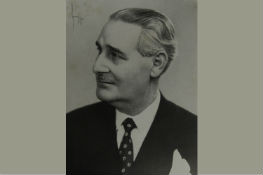Versione italiana English version Version française Versión en español
Melis de Villa Armando (1889-1961)
Born in Iglesias on 22nd May 1889, he graduated from the Polytechnic of Turin in 1920. He worked in Turin as an architect, first in close contact with Pietro Betta, also working on the construction of some pavilions for the Italian National Exhibition of Architecture at Valentino in 1928 together with the group GANT (Giovani Architetti Novatori Torinesi)which included, among others, Melis, Pietro Betta, Gino Levi Montalcini, Paolo Perona, Domenico Morelli and Mario Passanti. From 1936 he began his teaching career at the Polytechnic of Turin (Architectural Composition, then Characters distributive of buildings) in 1937, extraordinary professor of Distributive Characters of Buildings at the Faculty of Architecture in Turin in 1954, in 1957 he became a full professor. He was among the first in Italy to deal, in the '20s and '30s, with urban planning issues, until becoming an effective member of the National Institute of Urban Planning. Founder and director of the magazine Urbanistica (1932-45), he was also director of the magazine L'Architettura italiana (1933-1941). He drew up numerous plans. In Turin he took care of the redevelopment of the second section of Via Roma (1933 ff.). In the '40s and '50s he was active in the debates and operations that led to the formulation of the new Town Plan for Turin and for the province. In forty years of work he had a rich architectural production, not limited only to Turin and Piedmont, of which we give below a list as incomplete. Very often he leaned, for the technical solutions, to the engineer Bernocco.
Its most famous achievement is the skyscraper in the metal structure of Piazza Castello, with the building connected on Via Viotti (1933-1934) and the headquarters in Via Corte d'Appello 11 of the Società Reale Mutua Assicurazioni (1933); his are also the Koelliker house in Via Cavour corner Via Pomba (1928) and the Koelliker children's hospital, the Raveri house in Via Exilles, the building for the welfare services of the Fabbriche Riunite Industria Gomma ("Superga"), in Via Assisi 39 (1938) the houses in Corso Duca degli Abruzzi 32/34 (1948-1949, 1950-1951), the house S.C.E.I.A.T. in corso Re Umberto corner corso Matteotti, the house Ferrero Ventimiglia, the houses in via Giovanni da Verazzano 26 (1950-1952), in via Mombarcaro 13, in via Barletta 50 (1953-1954). His is also the bridge over the Po in Moncalieri (1940 ff.). He also built some important cemeteries in the monumental cemetery of Turin. As for its architectural production in Piedmont, mention should be made of the Vittorio Emanuele II Alpine Hotel Refuge at the Gran Paradiso, the new judicial prison of Novara (with Eng. Bernocco and Baretti) (1940), a private clinic in Aosta. On 1st November 1959, he was placed out of service by age. He died in Turin on 27th April 1961.
Bertagna Umberto (1936-2012)
Grandson of Armando Melis, he was active as a historian of architecture in Piedmont. A great archival researcher and expert in architectural drawings, he has left important publications. Supported by an almost legendary memory for drawings and documents, with a capillary knowledge such as to upset the acquired perspectives, the official historical reconstructions, he worked for decades collaborating on the main research initiatives implemented in his time, Just think of exhibitions such as Figurative and Architectural Cultura figurativa ed architettonica negli Stati del re di Sardegna (1980), ed alla successiva Rami incisi dell'Archivio di Corte, 1981. He was also a regular contributor to the periodicals Edilizia and Cronache economiche. His vision problems became more and more marked and he was prevented from writing over the years. In 2004 the magazine of the Library of History and Culture of Piedmont Paths dedicated a tribute to him republishing some of his notes on the history of architecture in Piemonte already printed on Edilizia, to thank him for the donation to the Library of his archive and his grandfather Armando Melis.
By Armando Melis De Villa and Umberto Bertagna, the library also houses particular bibliographical collections.
- Archive inventory Melis - Bertagna (pdf 797 KB)

